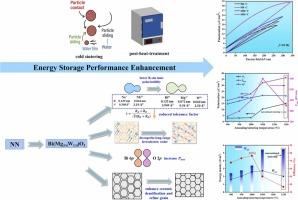采用冷烧结工艺制备纳米bo3 - bi (Mg3/4W1/4)O3弛豫铁电陶瓷,在中等电场条件下实现了增强的综合储能性能
IF 6.3
2区 材料科学
Q2 CHEMISTRY, PHYSICAL
引用次数: 0
摘要
NaNbO3陶瓷是公认的无铅介质储能材料,但由于其大量的残余极化,储能效率有限,阻碍了其实际应用。弛豫铁电体的设计和工程是大幅度提高其综合储能性能的一种有前途的策略。本研究采用常规固相烧结工艺制备了(1-x)NaNbO3-xBi(Mg3/4W1/4)O3 (NN-BMW)弛豫铁电陶瓷。系统地研究了NN-BMW陶瓷的微观结构特征、介电性能和储能性能。在290 kV/cm电场下,0.9NaNbO3-0.1Bi(Mg3/4W1/4)O3 (0.9NN-0.1BMW)陶瓷样品的可回收能量密度最高,为2.03 J/cm3,储能效率较低。为了进一步提高0.9NN-0.1BMW陶瓷的储能性能,采用了冷烧结与后退火相结合的技术。通过优化后退火温度,在1000℃下处理的0.9NN-0.1BMW陶瓷的可回收能量密度显著提高,达到2.59 J/cm3,储能效率达到76.5%,优于在1150℃下常规烧结制备的样品。这项工作阐述了一种低能量、环保的方法来合成具有优异综合储能性能的神经网络弛豫铁电陶瓷。本文章由计算机程序翻译,如有差异,请以英文原文为准。

Achieving enhanced comprehensive energy storage performances under moderate electric field in NaNbO3-Bi(Mg3/4W1/4)O3 relaxor ferroelectric ceramics via the cold sintering process
NaNbO3 ceramics, recognized as lead-free dielectric energy storage material, suffer from limited energy storage efficiency due to their substantial remnant polarization, which hinders their practical application. The design and engineering of relaxor ferroelectrics represent a promising strategy for substantially improving their comprehensive energy storage performance. In this study, (1-x)NaNbO3-xBi(Mg3/4W1/4)O3 (NN-BMW) relaxor ferroelectric ceramics were fabricated through a conventional solid-state sintering process. A systematic investigation was carried out to evaluate the microstructural characteristics, dielectric behavior, and energy storage performance of the NN-BMW ceramics. Among the ceramic samples, the 0.9NaNbO3-0.1Bi(Mg3/4W1/4)O3 (0.9NN-0.1BMW) ceramic demonstrated the highest recoverable energy density of 2.03 J/cm3 and the lower energy storage efficiency under an electric field of 290 kV/cm. To further enhance the energy storage performance of the 0.9NN-0.1BMW ceramic, a cold sintering technique combined with post-annealing was employed. By optimizing the post-annealing temperature, the 0.9NN-0.1BMW ceramic treated at 1000 °C exhibited significantly enhanced recoverable energy density of 2.59 J/cm3 and energy storage efficiency of 76.5 %, surpassing the sample prepared by conventional sintering at 1150 °C. This work illustrates a low-energy, eco-friendly method of synthesizing NN-based relaxor ferroelectric ceramics with superior comprehensive energy storage performances.
求助全文
通过发布文献求助,成功后即可免费获取论文全文。
去求助
来源期刊

Journal of Alloys and Compounds
工程技术-材料科学:综合
CiteScore
11.10
自引率
14.50%
发文量
5146
审稿时长
67 days
期刊介绍:
The Journal of Alloys and Compounds is intended to serve as an international medium for the publication of work on solid materials comprising compounds as well as alloys. Its great strength lies in the diversity of discipline which it encompasses, drawing together results from materials science, solid-state chemistry and physics.
 求助内容:
求助内容: 应助结果提醒方式:
应助结果提醒方式:


